TRAT PROVINCE THAILAND


TRAT PROVINCE THAILAND

With 52 large and small Islands featuring long, white, sandy Beaches and unspoiled coral reefs, Trat offers delightful scenery and a number of tranquil hideouts for Beach and nature-lovers. The province also serves as a major fruit-growing, Fishing, and gem mining region.
The City of Trat is the primary launching point for trips to the popular Koh Chang Island Group as well as for forays to visit both gem markets and Cambodian border markets. Like Chanthaburi, Trat is a very important ruby-mining province, with the most famous gem market located in Bo Rai District, some 50 kilometres north of the Cambodian border. Those enthralled by Shopping will be delighted as Trat has more markets for its size than almost any other town in Thailand due to bustling Cambodian and coastal trade.
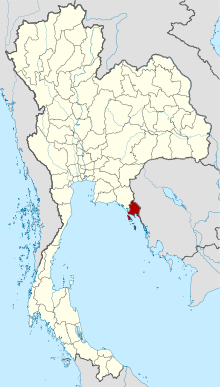
Trat town is the capital of Trat province. Located around 300km east of Bangkok and bordered by Chanthaburi province to the west and the Cambodian border to the east. The Cardamom (Khao Banthat) mountain range forms a natural border with Cambodia. Whilst offshore lie a total of 52 islands.
The climate in and around Trat is one of the wettest in the country. From May to October rainfall can be as much as 1,000mm per month. But as in all tropical countries, the heavy rain usually comes in torrential overnight downpours or short heavy showers during the daytime. There’s plenty of sunshine at this time of year. And consecutive grey and rainy days are pretty rare.
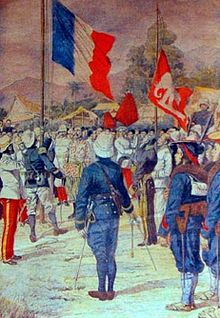
A Bit of History . . .
Before tourism the province was best known for fruit farming, fishing and gemstone mines. So basically, wasn’t of much use to the country. Therefore, it wasn’t a surprise when, in early 20th century, the Siamese Kingdom signed an agreement with France, surrendering Trat to the colonial political power. This was in return for France relinquishing their decade long occupation of Chanthaburi town, which was then an important trading post.
The good news was that only a couple of years later Thai King Rama V, regained control of Trat from the French. Achieved by basically swapping it for a huge chunk of northeastern Cambodia, which includes the modern day Cambodian provinces of Battambang, Siem Reap and Sisophon. (In modern day tourism terms, one of the architectural wonders of the World, Angkor Wat, was exchanged for some nice beaches. )
The agreement was signed on 23 March 1906, and is celebrated annually as Trat Independence Day. This is also the reason why you will see reg flags bearing a white elephant on the displayed proudly on streets and outside businesses in Trat. This was the Siamese flag at the time Trat regained independence.
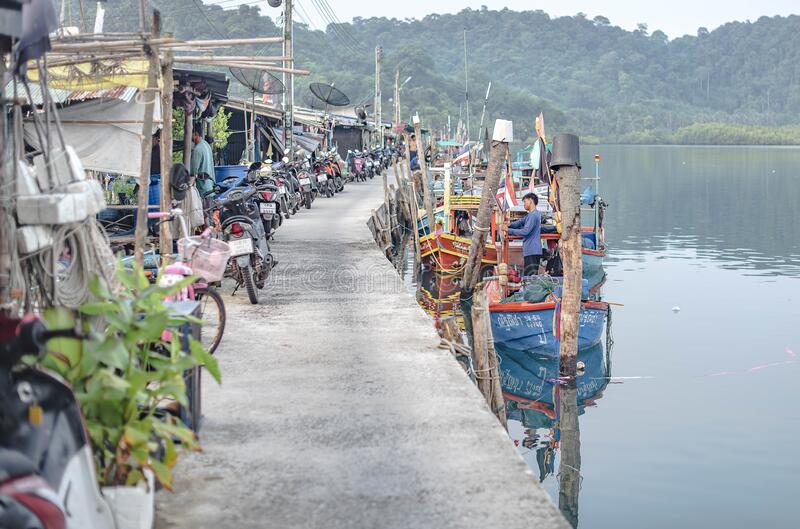
Trat town today . . .
However, if you haven’t committed genocide and would simply like to stay in Trat just to sample some local life, it’s definitely worth a couple of days of your time. There’s good value accommodation in modern hotels and also a range of budget guesthouses. The town is also well known for it’s bustling nightly street food market.
Trat town is a relatively sleepy place. The old riverside community lies just to the south of the centre, by the Bang Phra canal. It is here that you will still find narrow streets such as Thana Charoen Road, which is lined with old-fashioned houses and shops.
Of course nowadays these are interspersed with a few guesthouses, restaurants and small bars. Many years ago, the canal, which leads to the Trat river and then out to the sea. was a main route for trade. Islanders brought coconuts to sell and merchants from elsewhere on the eastern seaboard, and as far away as China, traded ceramic ware, herbs and spices. Murals on some of the house walls, depict the old lifestyle in the canal-side community.
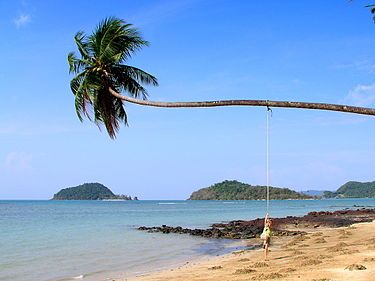
For visitors interested in learning more about the town and history of the province, Trat has a very nice museum. Trat Museum is housed in, what was once the City Hall, on Santisook Road. This is a large wooden building that was originally built during the French occupation. Over the years it fell into disrepair and was unused before being lovingly rebuilt in the early 2000s.
The museum covers the history of the Trat area. From prehistoric settlements. To it’s early days as an important stopover for Chinese traders. To the occupation by the French in the early 1900’s and the World War Two Battle of Koh Chang. Most information in both Thai & English. There are also several multimedia and video exhibits, again in both languages or with English subtitles. Entry to the museum is 30 Baht for foreign visitors.
Trat’s most famous temple ‘Wat Buppharam‘ lies about 25 minutes walk west of the town centre. It’s a very well maintained temple complex which dates back over 400 years. It was founded in 1648 during the reign of King Prasat Thong who founded Trat town. The original buildings were replaced with more modern designs in the late 19th century. However, the original, red, laterite block, bases of some buildings were left behind. There’s also a couple of small museums on site, which the monks will open up for interested visitors.
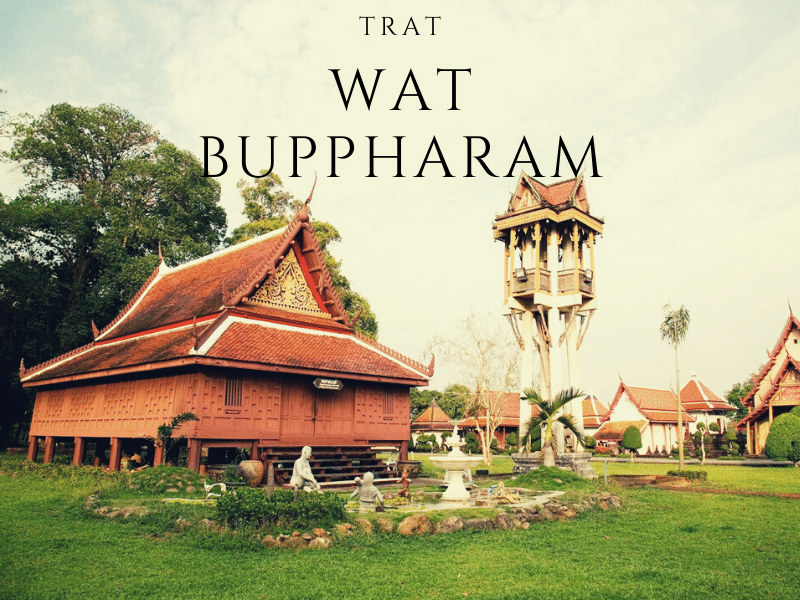
Hiring a bicycle is a good way to see around the town and once out of the centre the roads are good and there’s little traffic. Less than a kilometre west of Trat town, and 5 minutes ride from Wat Buppharam, is ‘Sa Sisiat’ a large reservoir that provides the towns water supply. Although it’s close to the town the area around it remains largely undeveloped and it’s home to a wide array of water birds. There are some restaurants and coffeeshops dotted around the lake which is circled by both a new cycling / running track and a narrow road. This is where you can meet some of the locals out for their morning run or bike ride.
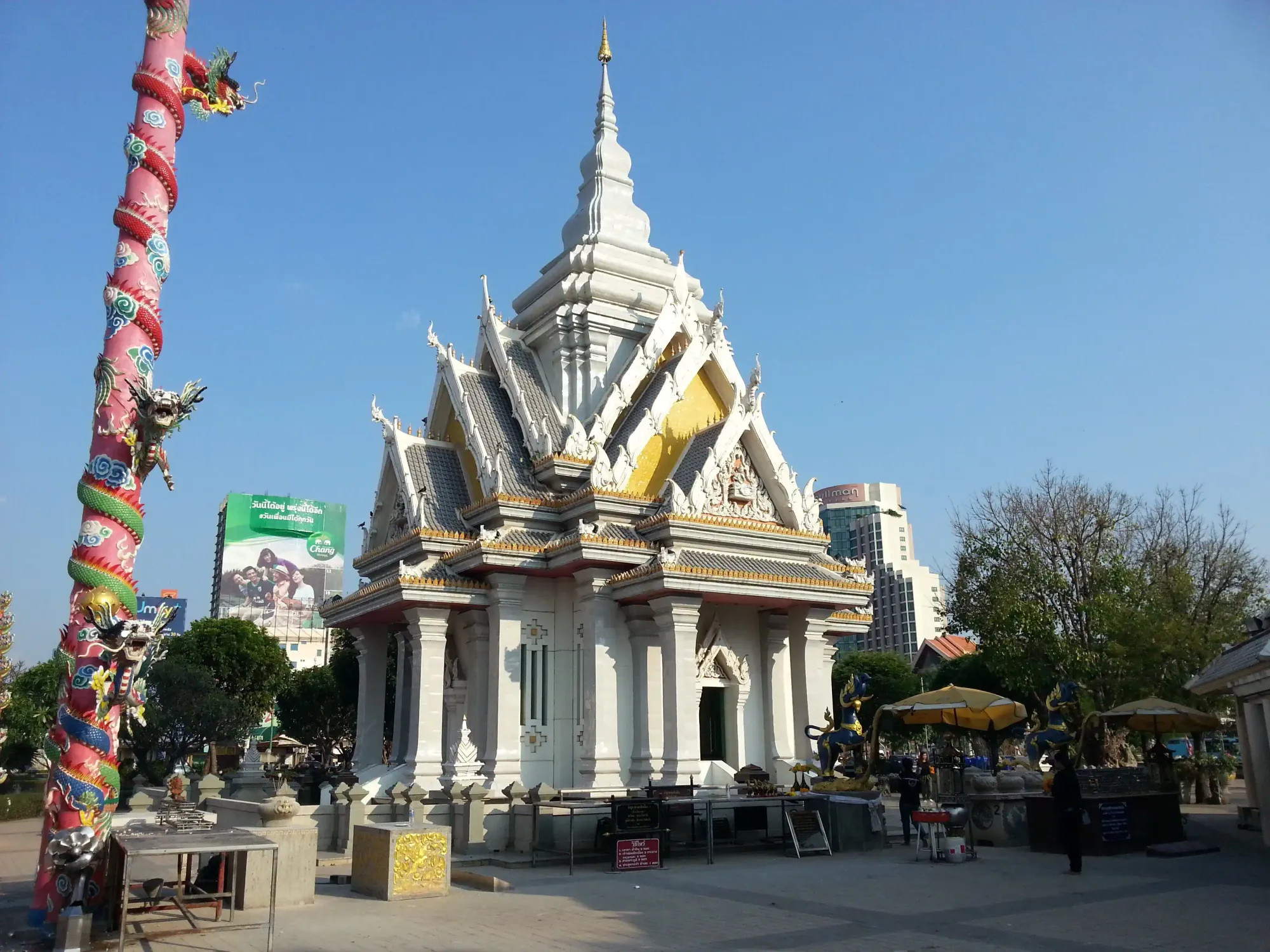
Closer to the centre, 200 metres west of the market, on Lak Mueang Road, lies the Chinese-style City Pillar Shrine (Chao Por Lak Mueang Shrine). This was built by King Taksin in the 1760s. The King visited the city in order to raise troops and also ordered a shrine to be built in a Chinese style. This was partly because Chinese wisdom said that all towns should have a central pillar which serves to protect the city from enemies and to bring peace to the people. And partly because it helped maintain a good relationship between local and Chinese traders.
Where to Stay in Trat town?
If value for money is important to you, then the accommodation in Trat definitely won’t disappoint you. Until just a decade ago finding a place to stay was limited to just a couple of old hotels and a handful of quaint but very basic guesthouses. Nowadays that’s changed and there are an increasing number of modern hotels and stylish guesthouses. And the best thing is that you’ll find it hard to spend more than 1,500 Baht / night even if you stay in the best hotels in town.
Rimklong Boutique Hotel was probably the first small, stylish hotel to open in the town centre. Run by the affable Mr Tooh, it’s one of the best guesthouses you will find anywhere on your travels. It’s located in the old town area in a renovated brick and wood shophouse and oozes old fashioned charm. Rooms for around 1,000 – 1,500 Baht / night depending on the season.
If you want the best views then the obvious choice is Canvas Family Home by Sa Sisiat reservoir, just outside the town centre. This is a stylish coffeeshop with a handful of spacious, well appointed rooms. The coffeeshop is often packed with locals at the weekend and during the week is a popular spot for lunch. Rooms are great value from under 1,000 Baht / night, They also have large Family rooms for well under 2,000 Baht / night. If views are a priority, go for the ‘Deluxe Room with Balcony’ with floor to ceiling windows and panoramic views across the reservoir.

Trat 101 Waterfront Hotel is a very tastefully rebuilt house on Thana Charoen Road in the old town. The air-conditioned ensuite rooms are quite small but are bright and open onto the garden and huge mango tree. A good choice if you want a mix of the old and new. From 700 Baht / night.
Where to Eat in Trat
For many local residents, eating in the town in centered around the two main markets. The large indoor market and the open air night market a couple of minutes walk north. The night market is marked by an overhead sign on the main road in Thai and English. The English version reads ‘Top street food in Trat by Trat people.

If the markets are a bit too basic for you, try SaengFa Restaurant on the main road, opposite the government hospital. This is locally owned and serves up delicious Thai and Chinese food in an air-conditioned dining room. The menu is in Thai & English. They also have a good coffeeshop with excellent homemade cakes. (The owner speaks good English as she studied abroad, which is where her love of real cakes came from.)
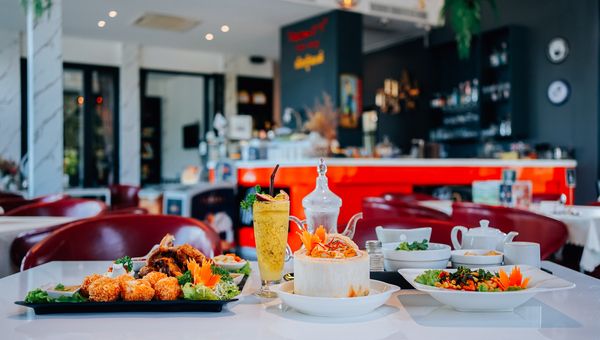
For some fusion food, and to hang out with the upper echelons of Trat society, head to Trat Marché – a hip coffeeshop / restaurant to the east of the town centre. The restaurant is famous for it’s ‘Pat krapow’ menu. This is a staple Thai dish, usually made with minced pork and served with rice. But here you can can mix and match ingredients and there’s a choice of over 100 variants of the dish. So no problem if you want to have it made with salmon and served with penne pasta.
How to Get to Trat?
Driving to Trat from Bangkok can be as simple as following Sukhumvit Road, from the centre of Bangkok all the way around the eastern seaboard, to the centre of Trat town. This road, Highway 3, was one of the first roads built in Thailand. However, there are shorter, more direct routes available now which the majority of buses, minibuses and private cars will use. Take the motorway out of Bangkok, then Highway 344 to Klaeng. Then join Highway 3 and head directly to Trat.
Air-Conditioned buses depart from Ekkamai (Eastern bus terminal for Bangkok) to Trat on an hourly basis from six in the morning to midnight. Trat bus station is located a kilometre north of the town centre, just off Highway 3. The ticket price is 240 Baht and the journey takes around 5 to 5 and a half hours. Bus tickets can be booked online at http://www.pns-allthai.com/en/booking_1.php
Getting from Trat to Koh Chang, Koh Kood, Koh Mak and the Cambodian border
It is easy to take songthaew (pick up truck taxi) from the bus station or your hotel to one of the boat piers. Songtaews to Ao Thammachat & Centrepoint piers (for boats to Koh Chang) , Krom Luang pier (for boats to Koh Mak) and Laem Sok pier (for boats to Koh Kood) depart regularly from Trat bus station. But note that whilst the last boat to Koh Chang is at 19:30. The last speedboat to Koh Mak is at 16:00. And, if you’re heading to Koh Kood, the last boat is at 15:00 during high Season and 13:00 during the low season.
THINGS YOU MAY NOT KNOW: Bordering Cambodia on one side and the Gulf of Thailand on the other, Trat province is a wonderful holiday destination with idyllic islands and a host of cultural activities to enjoy. With 52 islands in Trat, this East Coast province is the perfect location to go island hopping and explore the gorgeous Mu Ko Chang National Park. And with a range of community based tourism initiatives, Trat province is also a rewarding destination for anybody who wants to support responsible tourism in Thailand.
THINGS YOU MAY WANT TO SAVE: Digital images.
ZENTRAVELER SAYS: Not in a hurry... rent a horse and trot to Trat.
From here to Infinity is a relatively short ride! The next leg takes eons and eons as you fly through the Barycentric Dynamical Time Zone! …and on and on and on. Follow the Zentraveler Newsletter often for Travel, Health and Zen-like stories and such. Where else can you get a THREE IN ONE NEWSLETTER FOR THE PRICE OF FREE.

ZENTRAVELER IS A PERSONAL NEWSLETTER, DESIGNED TO GIVE TRAVEL, HEALTH, WRITING AND HUMOR INCLUDING HELPFUL HINTS WITH A ZEN LIKE QUALITY.
